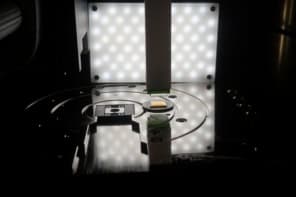
Physicists in the US have created the largest holographic display that can show different 3D images. The display is also the first to be based on a material known as a photorefractive polymer, which opens the door to even bigger dynamic displays.
The principle of making a hologram is straightforward. First, a single laser beam is split into an “object beam” and a “reference” beam. The object beam is directed to an object to be rendered, which scatters the light towards a plate. At the plate, this light mixes with that of the reference beam, producing an interference pattern that contains all the 3D information — that is, phase and amplitude — about the object. The interference pattern then just has to be stored in a suitable material, usually as a spatially varying absorption, thickness or refractive index.
For static holograms, there are many storage materials — indeed, commercially available static holograms can be bought in full colour and high resolution up to almost any size. The problem arises, however, if one wants a material that can display images that change over time. Physicists have managed this to some extent using, for example, “acousto-optic crystals”. But because the effect in these materials is fickle, the displays must be updated around 30 times a second, which is good for 3D video but can only be used to make tiny displays.
TV resolution
Nasser Peyghambarian and colleagues from the University of Arizona, in collaboration with Nitto Denko Technical Corporation in California, have now created an updatable holographic display that is 10 cm square with roughly the same resolution as a standard television (Nature 451 694). “The updateable holographic display represents the middle ground between low-resolution, small dynamic displays and high-resolution, large, static displays,” Nasser told physicsworld.com.
The display is made of a photorefractive polymer, in which mobile charge carriers accumulate in the light and dark patches of the interference pattern, creating a spatially-varying electric field. This field forces the polymer’s refractive index into a profile matching the interference pattern, which can remain stored for around three hours, or until the charge carriers are dispersed with a uniform “eraser” beam.
The team are now trying to increase the size of the displays and reduce the writing time for showing video. Peyghambarian says they have “encouraging” results in full-colour versions. Progress in this area will be attractive for applications in medicine, where surgeons could see complex operations progress in real-time 3D; or for the military, to give an instant view of the location of enemy fighters.




